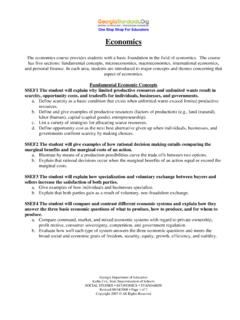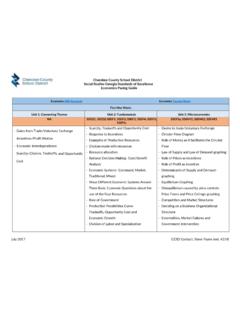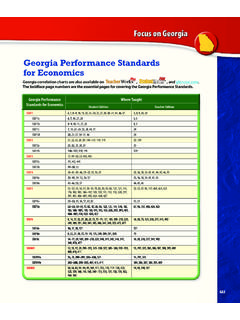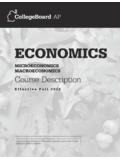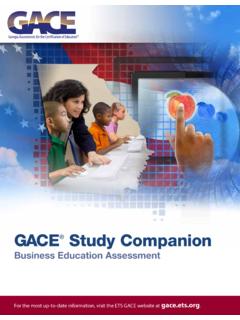Transcription of Plan 3 for 2nd and 3rd grades - Roswell, Georgia - …
1 Lesson Plan 3 for 2nd and 3rd grades Social Studies/ grades 2 and 3 Language Arts/ grade 2 and 3 ECONOMICS/ Hook Activity: Introduction: Goods and Services in Georgia standards /Elements SS2E1 The student will explain that because of scarcity, people must make choices and incur opportunity costs. SS2E2 The student will identify ways in which goods and services are allocated (by price; majority rule; contests; force; sharing; lottery; command; first come, first served ; personal characteristics; and others). SS2E3 The student will explain that people usually use money to obtain the goods and services they want and explain how money makes trade easier than barter. SS2E4 The student will describe the costs and benefits of personal spending and saving choices. economic Understandings SS3E1 The student will describe the four types of productive resources: a. Natural (land) b. Human (labor) c.
2 Capital (capital goods) d. Entrepreneurship (used to create goods and services) Essential Questions What are wants? What are goods? What are needs? What are services? Materials needed Vocabulary Worksheet on the Roswell Mill, Want and Needs worksheet. Lesson 3 Students will read the introduction paragraphs together on the Roswell Mill. Teacher will introduce them to what life was like in the early 1800s. Teacher will ask students to share a couple of things that are alike between children today and children in the 1800s and things that are different. Teacher will record these ideas on chart paper. If students do not mention services, goods, wants and needs, the teacher will introduce. Students will be asked to define these four terms and teacher will discuss their meanings. Teacher will then ask students to imagine that they are a child in the 1800s and their family is moving to Georgia .
3 The teacher will ask the students to imagine what their family will need. Students will be divided into small groups to discuss and record the wants and needs of their family. (Examples: food, shelter, transportation) After each group has compiled a list, they will share their ideas with the class. (These charts could be displayed around the room.) Assessment Students will complete the wants and needs worksheet and teacher should review the answers upon completion. Ideas for Extending the Lesson Students could be asked to group their small group chart into categories (wants or needs in modern times in Georgia and/or goods or services and wants and needs in current day Georgia ) and compare and contrast them to their colonial charts. Students could also make a list of things that they imagine people needed to work in a mill. This could further a discussion on natural resources of Georgia or man/tool made resources for Georgia .
4 Cross Curriculum Connection Reading The following books relate to this economics lesson. These stories can be used to introduce a visit to the Roswell Mill or can be read aloud during a reading block. If multiple copies are available, they could be used for small group reading instruction. They could also be stored in the reading area for independent reading time. Look Homeward Hannah Lee by Patricia Beatty. I Live in Georgia by Cathy Hodge The Rolling Stone by Angela Johnson The Tortilla Factory by Gary Paulsen Evan s Corner by Elizabeth Hill Uncle Jed s Barbershop by Margaree K. Mitchell Technology These websites can be used as a ready reference or as an extension of learning. , , , THE ROSWELL MILL Roswell King began the Roswell Cotton Mill In 1839. The Roswell Manufacturing Company had 150 people working at the mill. Unfortunately, King s wife, Catherine, never saw her family s enterprise, nor the town that would be named for her husband.
5 She died while still living in South Georgia in a town called Darien. In 1844, Roswell King died and the couple s son, Barrington King, worked to carry on his father s dream. He served as president of the Roswell Manufacturing Company for twenty seven years, from its incorporation in 1839 until his death in 1866. The Roswell area was part of Cobb County, Georgia when it was first settled, and the county seat of Marietta was a four hour (one way) horseback ride to the west. Since Roswell residents desired a local government, they submitted a city charter for incorporation to the Georgia General Assembly. The charter was approved on February 16, 1854. By the time of the Civil War, the cotton mill employed more than 400 people, mostly women. Given settlement patterns in the Piedmont, they were likely of Scots Irish descent. As the mill increased in production, so did the number of people living in the area.
6 Life in a Mill Town for Children Children were dressed like little adults and treated like adults. Many were expected to go to work as early as 5 or 6. They were probably more serious than our children. They worked in a dangerous factory and did not have much time to play. Girls were often married at 15 or 16 and, in the middle to lower classes, boys were expected to decide by the age of 10 what trade they wanted to go into, so they could be apprenticed. Schools were a new thing in America and there were no laws that said children had to go to school. Children went to school when they could and often taught themselves after work. Girls in the upper classes were taught to read and poetry and classic novels but were discouraged from learning anything more than "feminine accomplishments , such as playing the piano, drawing, or doing needlework. Poor girls were lucky to be able to read, but often knew something the wealthier girls did not: how to run a household.
7 Name _____ Wants and Needs I. Pretend you are a child in the 1800s moving to Roswell, Georgia so your parents can work in the Roswell Mill. What do you need to pack for your basic needs. Your basic needs are food, clothing, and shelter. Directions: Color and cut out each picture. Glue the pictures of your basic needs to the correct suitcase. On the back of this paper, glue the wants that you can not take on the trip. Vocabulary List factory mill cotton Roswell King Barrington King Upper class Middle class Lower class Apprentice Novel Poem

